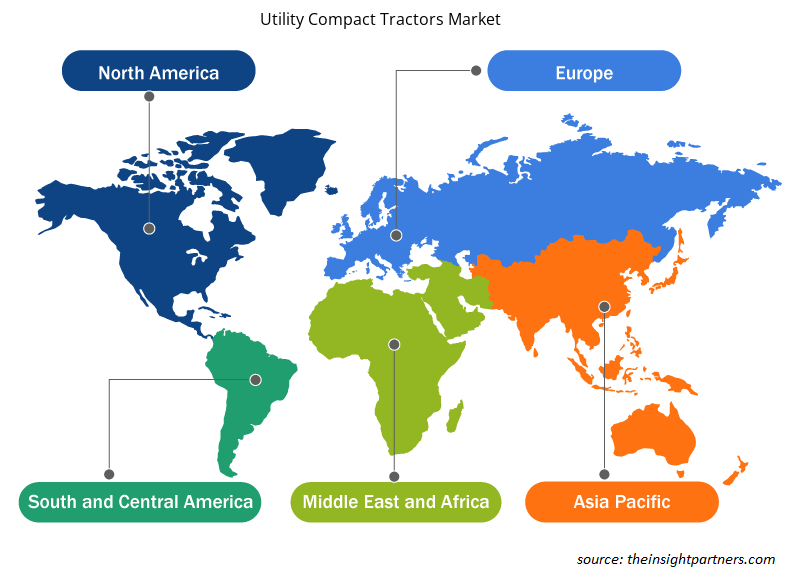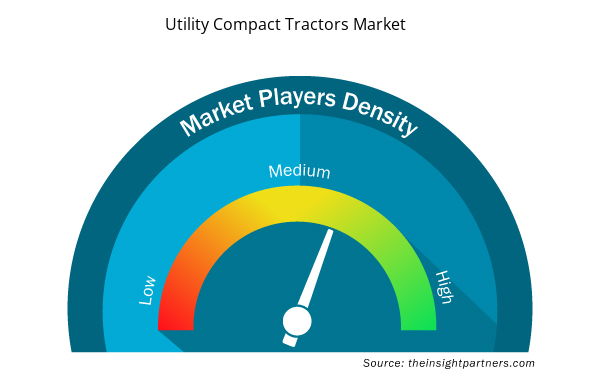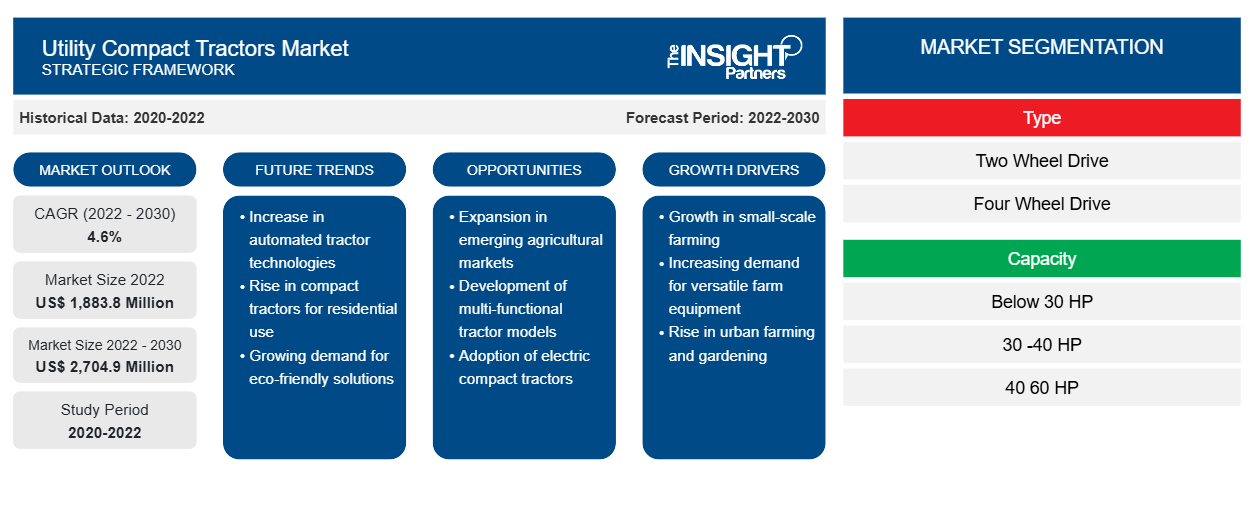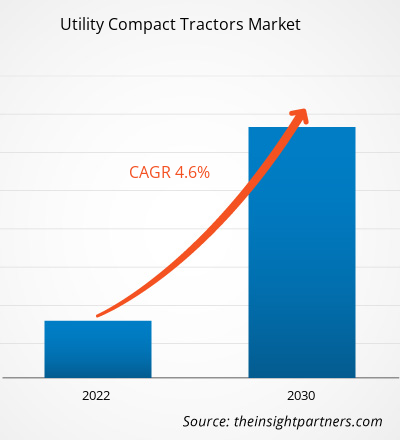[研究报告] 多功能紧凑型拖拉机市场规模预计将从 2022 年的 18.838 亿美元激增至 2030 年的 27.049 亿美元;预计 2022 年至 2030 年的复合年增长率为 4.6%。
分析师观点:
紧凑型拖拉机在建筑、园林绿化、动物管理和草坪管理中的使用增加是推动多功能紧凑型拖拉机市场增长的重要因素。这些拖拉机用于起重、割草、拖曳、拖运和土壤管理活动。园林绿化项目投资的增加和建筑业的蓬勃发展直接推动了多功能紧凑型拖拉机的采用。根据牛津经济研究院 2023 年发布的数据,建筑工程的价值预计将从 2022 年的 9.7 万亿美元增加到 2037 年的 13.9 万亿美元,其中中国、美国和印度等巨型市场将引领这一趋势。印度正在成为增长最快的建筑超级大国之一,而英国预计将成为西欧增长最快的建筑市场。此外,降雪在德国、法国、俄罗斯、挪威、瑞士、西班牙和瑞典等国家是一种常见现象,紧凑型多功能拖拉机通常用于除雪作业。 2023 年 12 月,莫斯科遭遇大雪,交通中断。根据俄罗斯政府提供的数据,大约有 20,000 台设备(包括多功能紧凑型拖拉机)被用于清理积雪。因此,除雪需求以及日益增多的园林绿化和建筑项目推动了欧洲以及世界其他地区对多功能紧凑型拖拉机的采用。
市场概况:
虽然小型拖拉机在农业活动中的应用更为普遍,但它们也被用于建筑、采矿、园林绿化和割草活动。与全尺寸拖拉机相比,这些拖拉机经济实惠且易于维护。此外,由于其设计和紧凑而强大的发动机,紧凑型拖拉机可以在狭小空间内轻松管理。紧凑型多用途拖拉机有各种驱动类型,例如传统内燃机和全电动机
预计亚太地区将为全球和国内紧凑型多用途拖拉机供应商创造丰厚的机会,这主要是由于建筑业和采矿业的持续增长。根据牛津经济研究院 2023 年发布的数据,预计到 2030 年,亚太地区将为全球建筑业创造 7.4 万亿美元的收入。此外,由于该地区工业的持续增长,预计未来几年采矿活动将迅速扩大。因此,工业部门的持续增长最终支持了多用途紧凑型拖拉机市场的增长。预计未来几年北美和欧洲将在全球市场上实现强劲增长率。加拿大、德国、奥地利、俄罗斯和瑞典等降雪率最高。此外,与美国其他国家相比,对园林绿化和草坪管理的需求很高。因此,这些国家采用多用途紧凑型拖拉机进行除雪和园林绿化活动的比例更高。
定制此报告以满足您的需求
您可以免费定制任何报告,包括本报告的部分内容、国家级分析、Excel 数据包,以及为初创企业和大学提供优惠和折扣
- 获取此报告的关键市场趋势。这个免费样品将包括数据分析,从市场趋势到估计和预测。
市场驱动因素:
园林绿化和草坪护理服务需求不断增长
草坪护理服务通常涵盖与草坪和土壤管理及其保养相关的广泛活动。这些包括割草、修边、修剪、施肥、除草、昆虫管理和浇水。一些草坪护理企业可能会提供额外的服务,例如曝气、补播和草皮安装。根据 Insight Partners 在 2022 年的分析,景观和草坪护理服务在 2022 年达到约 2000 亿美元。美国是景观和草坪护理服务的主要市场之一。美国消费者在专业景观和草坪护理服务上花费约 300 亿美元。此外,政府在景观改善方面的支出是另一个有利于景观行业并最终有利于多功能小型拖拉机市场的因素。例如,2023 年 12 月,美国政府宣布拨款 1.61 亿美元用于景观修复活动。借助这笔资金,政府预计将完成 21 个景观的修复。此类服务支出的增加推动了对园林绿化设备(如多功能紧凑型拖拉机)的需求。因此,对园林绿化和草坪护理服务的需求增加大大促进了多功能紧凑型拖拉机市场规模的扩大。
节段分析:
多功能紧凑型拖拉机市场分析考虑了以下几个部分:类型、容量和驱动类型。根据容量,市场细分为 30 马力以下、30-40 马力和 40-60 马力。2022 年,40-60 马力细分市场占多功能紧凑型拖拉机市场份额的 60% 以上
40-60 HP 级多功能紧凑型拖拉机被园林绿化和草坪护理服务提供商广泛用于犁地、载重和拖运等活动。紧凑型拖拉机制造商的产品开发活动进一步推动了市场的发展。例如,2023 年 2 月,久保田推出了功率为 40HP 的 LX4020 紧凑型拖拉机。该型号具有更宽的轴,从而提高了整体机动性,使其更适合景观和草坪护理操作。
区域分析:
多功能紧凑型拖拉机市场报告的地理范围包括北美(美国、加拿大和墨西哥)、欧洲(西班牙、英国、德国、法国、意大利和欧洲其他地区)、亚太地区(韩国、中国、印度、日本、澳大利亚和亚太其他地区)、中东和非洲(南非、沙特阿拉伯、阿联酋和中东和非洲其他地区)以及南美洲和中美洲(巴西、阿根廷和南美洲和中美洲其他地区)。北美多功能紧凑型拖拉机市场分为美国、加拿大和墨西哥。美国、加拿大和墨西哥等国家的景观和草坪护理维护行业主要推动了对多功能紧凑型拖拉机的需求。
由于景观和建筑业的稳步增长,预计北美将在未来几年继续占据多功能紧凑型拖拉机市场份额。建筑业是美国经济的重要贡献者。2023 年第一季度,该国约有 919,000 家建筑公司,每年完成价值约 2.1 万亿美元的建筑项目。在加拿大,建筑业是 2022 年 GDP 的第六大贡献者。2022 年,加拿大建筑业的年收入约为 2500 亿美元。除了该行业的需求外,加拿大各州的强降雪也是推动采用多功能紧凑型拖拉机的一个显着因素。在美国,对碳排放的偏好增加和电动汽车的采用率不断提高,预计将在来年带来新的多功能紧凑型拖拉机市场趋势。
多功能小型拖拉机市场区域洞察
Insight Partners 的分析师已详尽解释了预测期内影响多功能紧凑型拖拉机市场的区域趋势和因素。本节还讨论了北美、欧洲、亚太地区、中东和非洲以及南美和中美洲的多功能紧凑型拖拉机市场细分和地理位置。

- 获取多功能紧凑型拖拉机市场的区域特定数据
多功能小型拖拉机市场报告范围
| 报告属性 | 细节 |
|---|---|
| 2022 年市场规模 | 18.838 亿美元 |
| 2030 年的市场规模 | 27.049 亿美元 |
| 全球复合年增长率(2022 - 2030 年) | 4.6% |
| 史料 | 2020-2022 |
| 预测期 | 2022-2030 |
| 涵盖的领域 | 按类型
|
| 覆盖地区和国家 | 北美
|
| 市场领导者和主要公司简介 |
|
多功能小型拖拉机市场参与者密度:了解其对业务动态的影响
多功能小型拖拉机市场正在快速增长,这得益于终端用户需求的不断增长,这些需求源于消费者偏好的不断变化、技术进步以及对产品优势的认识不断提高等因素。随着需求的增加,企业正在扩大其产品范围,进行创新以满足消费者需求,并利用新兴趋势,从而进一步推动市场增长。
市场参与者密度是指在特定市场或行业内运营的企业或公司的分布情况。它表明相对于给定市场空间的规模或总市场价值,有多少竞争对手(市场参与者)存在于该市场空间中。
在多功能小型拖拉机市场运营的主要公司有:
- 洋马拖拉机
- 马恒达
- 泰懋股份有限公司
- 索莱克
- 约翰迪尔
免责声明:上面列出的公司没有按照任何特定顺序排列。

- 获取多功能紧凑型拖拉机市场顶级关键参与者概览
关键球员分析:
山猫公司、马恒达拖拉机、久保田、约翰迪尔、麦赛福格森、TYM、洋马和纽荷兰是多功能小型拖拉机市场报告中介绍的知名企业。此外,在本次市场研究中,还研究和分析了其他几家重要公司,以全面了解市场。
最新动态:
多功能小型拖拉机市场中的公司广泛采用并购等无机和有机战略。以下列出了主要市场参与者的一些最新发展:
年 | 消息 | 地区 |
2023 年 3 月 | TYM 推出了配备远程信息处理系统(仅限 T76)和液压上连杆的 4 款新系列拖拉机。 | 亚太地区 |
2023 年 5 月 | 约翰迪尔 (John Deere) 推出了 2024 款 3R 和 4 系列紧凑型多用途拖拉机的增强功能。这些拖拉机配备了可用于商业除雪的配件。 | 北美 |
- 历史分析(2 年)、基准年、预测(7 年)及复合年增长率
- PEST 和 SWOT 分析
- 市场规模价值/数量 - 全球、区域、国家
- 行业和竞争格局
- Excel 数据集



Report Coverage
Revenue forecast, Company Analysis, Industry landscape, Growth factors, and Trends

Segment Covered
This text is related
to segments covered.

Regional Scope
North America, Europe, Asia Pacific, Middle East & Africa, South & Central America

Country Scope
This text is related
to country scope.
常见问题
Regions such as Europe, North America and Asia-Pacific will boost the growth of the utility compact tractors market during the forecast period. The demand for the utility compact tractors in Europe and North America is mainly attributed increased investments for the snow removal equipment.
AGCO GmbH, Yamaha Tractors, Solis, Bobcat Company, Mahindra Tractors, Kubota, John Deere, Massey Ferguson, and New Holland are the key market players operating in the global utility compact tractors market.
Increased adoption in the construction industry is one of the primary factors behind the market growth. Global construction activity is expected to expand by 1.2% in 2024, reaching a value of US$ 9.6 trillion. Total construction activity is expected to reach a value of US$ 9.9 trillion by 2025, with a growth rate of 3.6%; Further, it is estimated to reach US$ 10.1 trillion by 2028, growing at a CAGR of 2.2%.
Continuous adoption of electric vehicles owing to increased focus on sustainability is one of the trends that is expected to drive the demand of the electric utility compact tractors market.
Many compact tractor manufacturers are focusing on developing fully automated compact tractors. Such development is projected to generate lucrative opportunities for the utility compact tractors market during the forecast period.
Trends and growth analysis reports related to Manufacturing and Construction : READ MORE..
The List of Companies - Utility Compact Tractors Market
- YANMAR Tractor
- Mahindra
- TYM CORPORATION
- Solectrac
- John Deere
- AGCO GmbH
- Bobcat Company
- New Hollland
- Massey Ferguson
- LS Tractors
- Iseki & Co., Ltd.
- Deutz-Fahr
The Insight Partners performs research in 4 major stages: Data Collection & Secondary Research, Primary Research, Data Analysis and Data Triangulation & Final Review.
- Data Collection and Secondary Research:
As a market research and consulting firm operating from a decade, we have published and advised several client across the globe. First step for any study will start with an assessment of currently available data and insights from existing reports. Further, historical and current market information is collected from Investor Presentations, Annual Reports, SEC Filings, etc., and other information related to company’s performance and market positioning are gathered from Paid Databases (Factiva, Hoovers, and Reuters) and various other publications available in public domain.
Several associations trade associates, technical forums, institutes, societies and organization are accessed to gain technical as well as market related insights through their publications such as research papers, blogs and press releases related to the studies are referred to get cues about the market. Further, white papers, journals, magazines, and other news articles published in last 3 years are scrutinized and analyzed to understand the current market trends.
- Primary Research:
The primarily interview analysis comprise of data obtained from industry participants interview and answers to survey questions gathered by in-house primary team.
For primary research, interviews are conducted with industry experts/CEOs/Marketing Managers/VPs/Subject Matter Experts from both demand and supply side to get a 360-degree view of the market. The primary team conducts several interviews based on the complexity of the markets to understand the various market trends and dynamics which makes research more credible and precise.
A typical research interview fulfils the following functions:
- Provides first-hand information on the market size, market trends, growth trends, competitive landscape, and outlook
- Validates and strengthens in-house secondary research findings
- Develops the analysis team’s expertise and market understanding
Primary research involves email interactions and telephone interviews for each market, category, segment, and sub-segment across geographies. The participants who typically take part in such a process include, but are not limited to:
- Industry participants: VPs, business development managers, market intelligence managers and national sales managers
- Outside experts: Valuation experts, research analysts and key opinion leaders specializing in the electronics and semiconductor industry.
Below is the breakup of our primary respondents by company, designation, and region:

Once we receive the confirmation from primary research sources or primary respondents, we finalize the base year market estimation and forecast the data as per the macroeconomic and microeconomic factors assessed during data collection.
- Data Analysis:
Once data is validated through both secondary as well as primary respondents, we finalize the market estimations by hypothesis formulation and factor analysis at regional and country level.
- Macro-Economic Factor Analysis:
We analyse macroeconomic indicators such the gross domestic product (GDP), increase in the demand for goods and services across industries, technological advancement, regional economic growth, governmental policies, the influence of COVID-19, PEST analysis, and other aspects. This analysis aids in setting benchmarks for various nations/regions and approximating market splits. Additionally, the general trend of the aforementioned components aid in determining the market's development possibilities.
- Country Level Data:
Various factors that are especially aligned to the country are taken into account to determine the market size for a certain area and country, including the presence of vendors, such as headquarters and offices, the country's GDP, demand patterns, and industry growth. To comprehend the market dynamics for the nation, a number of growth variables, inhibitors, application areas, and current market trends are researched. The aforementioned elements aid in determining the country's overall market's growth potential.
- Company Profile:
The “Table of Contents” is formulated by listing and analyzing more than 25 - 30 companies operating in the market ecosystem across geographies. However, we profile only 10 companies as a standard practice in our syndicate reports. These 10 companies comprise leading, emerging, and regional players. Nonetheless, our analysis is not restricted to the 10 listed companies, we also analyze other companies present in the market to develop a holistic view and understand the prevailing trends. The “Company Profiles” section in the report covers key facts, business description, products & services, financial information, SWOT analysis, and key developments. The financial information presented is extracted from the annual reports and official documents of the publicly listed companies. Upon collecting the information for the sections of respective companies, we verify them via various primary sources and then compile the data in respective company profiles. The company level information helps us in deriving the base number as well as in forecasting the market size.
- Developing Base Number:
Aggregation of sales statistics (2020-2022) and macro-economic factor, and other secondary and primary research insights are utilized to arrive at base number and related market shares for 2022. The data gaps are identified in this step and relevant market data is analyzed, collected from paid primary interviews or databases. On finalizing the base year market size, forecasts are developed on the basis of macro-economic, industry and market growth factors and company level analysis.
- Data Triangulation and Final Review:
The market findings and base year market size calculations are validated from supply as well as demand side. Demand side validations are based on macro-economic factor analysis and benchmarks for respective regions and countries. In case of supply side validations, revenues of major companies are estimated (in case not available) based on industry benchmark, approximate number of employees, product portfolio, and primary interviews revenues are gathered. Further revenue from target product/service segment is assessed to avoid overshooting of market statistics. In case of heavy deviations between supply and demand side values, all thes steps are repeated to achieve synchronization.
We follow an iterative model, wherein we share our research findings with Subject Matter Experts (SME’s) and Key Opinion Leaders (KOLs) until consensus view of the market is not formulated – this model negates any drastic deviation in the opinions of experts. Only validated and universally acceptable research findings are quoted in our reports.
We have important check points that we use to validate our research findings – which we call – data triangulation, where we validate the information, we generate from secondary sources with primary interviews and then we re-validate with our internal data bases and Subject matter experts. This comprehensive model enables us to deliver high quality, reliable data in shortest possible time.


 获取此报告的免费样本
获取此报告的免费样本